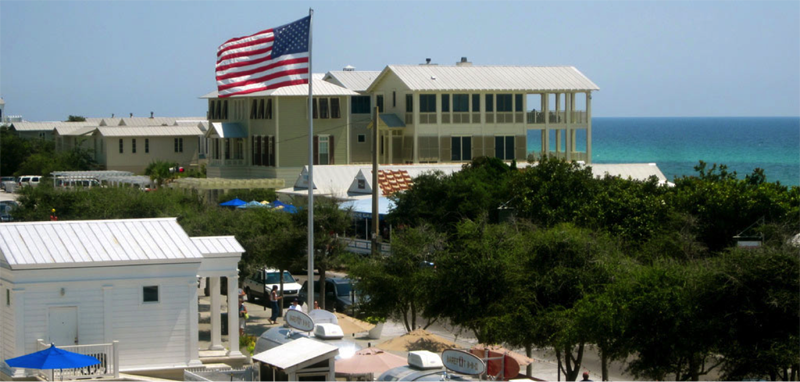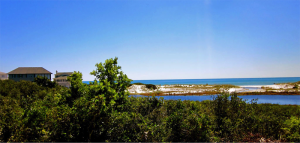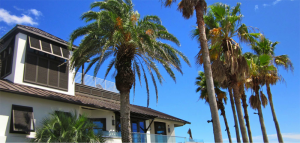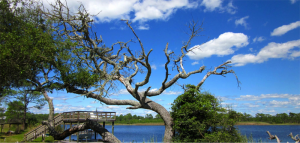“Life shines” on Florida’s Scenic Highway 30-A, a 20-mile meandering shore tucked very quietly between Destin and Panama City Beach. Since so many East Cobb families are spending their Spring Break on 30-A, the EAST COBBER presents a visitor’s guide to 30-A.
Scenic 30-A runs through long-leaf pine flatwoods, along the white sand beach and sea oat-covered dunes, past freshwater coastal lakes and saltwater inlets, over sand hills and coastal uplands, along wetlands and marshes, through hardwood hammocks and coastal scrub. This area is known for the shimmering brilliance of the Gulf of Mexico and her white sand beaches. But it is the beauty of the landscape and its native plants and animals that are second to none.
- Don’t miss the centuries-old live oaks at Eden State Gardens in Pt. Washington State Park, and the craggy, many-trunked scrub oaks in Old Grayton Beach.
- Look for the huge, fragrant white blooms of Southern Magnolia in early summer throughout the woods, at the crest of Old Seagrove, and next to the obelisk beach walkover in Seaside.
- Admire the graceful arc of slash pine reflected in Western Lake.
- Discover the tough little sand pine that grows all along the Gulf Coast, but nowhere else in the world! Look closely at the sharp-toothed edge of the stem of a palmetto frond that gives Saw Palmetto, a palm tree that grows its trunk underground, its name.
- Wildflowers bloom year-round along Scenic 30-A. Watch for the lavender blossoms of wild rosemary and Gulf Coast lupine in the spring.
- In the fall, the roadsides turn gold with goldenrod, woody goldenrod, golden asters and camphorweed. Sea oats, the grasses that hold the dunes in place, are a federally protected species
- Enjoy the beauty of the plants, but please, don’t walk on the dunes or pick the seed heads. Please do enjoy and protect the beauty of the beaches, dunes, scrub and woodlands.
Taking the Scenic Route Along 30-A
From where it departs and connects with US 98, Scenic 30-A is comprised of 18.5-miles, plus 9.4 miles of connector roads—83 and 283—from the Gulf of Mexico to US 98, and 395 from the Gulf of Mexico to the Choctawhatchee Bay. “Taking the scenic route” by car, bicycle, or on foot, you’ll journey past four state parks, 27 miles of greenway trails, 11 rare coastal dune lakes, 12 beach communities. And you’ll behold miles of stunningly beautiful beaches. Scenic 30-A is a tourist attraction of major proportions. It is an exciting and eclectic mix of hot Caribbean colors and soft pastels, with architecture to match each beach community’s aesthetic, whether it be Old Florida’s traditional 2-3 story homes, or the cottages of Seaside with white picket fences and pedestrian pathways to New Urbanism, or its miles of greenway trails connecting state parks, preserves and residential areas.
Remarkably, all of Scenic 30-A’s famous beaches are certified as Blue Wave Beaches, akin to the Good Housekeeping Seal of Approval when it comes to cleanliness and safety. Scenic 30-A’s shimmering sugar-fine sands combined with shades of turquoise-blue and emerald-green waters are breathtakingly beautiful, sun up or sun down. Scenic 30-A’s beaches are naturally beautiful—no dredging and filling has replaced the crystalline grains of sand that squeak when you walk on them. Beach nourishment, the formation of sand dunes, and other educational programs to Keep Off the Dunes, are critical to protecting the Gulf Shores and Scenic 30-A’s reputation as the tourist destination known for its world-class beaches.
When Gulf breezes blow, a unique combination of sea oat grasses and coastal scrub vegetation trap the sugar sands, causing dunes to form. One of the most dazzling dunes—rising 25 feet above sea level— is at Topsail Hill Preserve. Traveling west along Scenic 30-A and just off US 98, you’ll come to Topsail, home to the endangered Choctawhatchee Beach Mouse, herons, egrets, white-tailed deer, fox, coyote, raccoon and gopher tortoises. Sea turtles come ashore late spring and summer to nest. Topsail is also home to 14 natural wild plant communities. Trailer Life magazine rated Topsail Hill RV Resort in the top 1% in the US.
Old Florida Architecture Along 30-A
Along Scenic 30-A, you’ll see numerous examples of Old Florida architecture–shingles, shutters, and shakes–overhangs that provide shade, and porches that suggest Southern hospitality. There are 12 distinct beach communities along the route and one just off the route on US98 (from west to east): Dune Allen Beach, Santa Rosa Beach, Blue Mountain Beach, Grayton Beach, WaterColor, Seaside, Seagrove Beach, WaterSound Beach, Seacrest Beach, Rosemary Beach, Inlet Beach and Carillon Beach (just off Scenic 30-A, on US98).
Scenic 30-A has 11 coastal dune lakes, known by kayaking and canoeing enthusiasts for their beauty and tranquility. Dune lakes are formed by the wind and found almost exclusively along the Gulf Coast. Classified as “critically imperiled” because of their extreme rarity, dune lakes are biologically diverse–salt water combined with fresh water—an important source of fresh water to migrating birds and other beach organisms—and any alteration to their drainage is a threat. Conservationists say the dune lake system’s intrinsic value is “incalculable.”
Elegant, coastal pine forests and the century-old community of Grayton Beach border one of the largest and most scenic of the dune lakes, the 220-acre Western Lake. Army Major Charles T. Gray and his wife Elizabeth built a home there in 1885. It later burned down. In 1913 Grayton Beach became a resort community when the Butler family settled in, adding rental cottages and a General Store that— come Saturday night— became a dance hall. Even as it grows at a furious pace, with upscale shops, beach-y kiosks and restaurants that range from the fun ‘n’ funky Picolo’s/Red Bar to Criolla’s award-winning Creole/Caribbean cuisine, Grayton Beach has maintained it’s small-town flavor. Grayton Beach State Recreation Park’s 2,228 acres opened in 1968. Sea turtles nest in the summer and shorebirds are numerous. Wildflowers include lupine, gaillardia and golden aster. Tread Softly signs dot the landscape of rolling, sea oat-covered dunes and glistening-white sandy beaches that taper into the blue-green Gulf.
Development is taking placing all along Scenic 30-A, adding a sense of vitality and anticipation. The St. Joe Company, Florida’s largest private landowner, with its emphasis on place-making, conservation and responsible development, is making a statement of excellence with its planned community of WaterColor. With its eye-pleasing palette of periwinkle blue and celadon green ceramic tiles in waterfalls, koi fish ponds, fountains, and numerous recreational opportunities, both WaterColor the community, and the small, 60-room WaterColor Inn, are fine examples of vernacular architecture. WaterColor blends right into the hustle and bustle of Seaside, which most consider the cultural and commercial center of Scenic 30-A.
Noting its numerous prestigious architectural awards, Time magazine described Seaside as the most astounding design achievement of its era. With a postage stamp-sized post office and a Town Center that boasts its own stage on the green, Seaside also has an artists’ colony and a full calendar of cultural events to put it on the map as a Must See. Picturesque as a postcard and the film location for The Truman Show, Seaside is a busy little success story—visitors flock to its shores in droves. The Seaside Institute sponsors significant intellectual and philosophical exchanges here and abroad on what makes a community vital.
Journeying on to Old Seagrove and Seagrove Beach, you’ll sense a slightly slower pace, but Seagrove is booming with residential and commercial development. Turning left at the corner of Scenic 30-A and 395, you’ll come to the Eastern Lake Bike/Hike Trail in Pt. Washington State Forest . Three greenway trails loop through sandhills, cypress ponds, wet prairies and titi swamps. Look for deer, coyote, alligator, and the gopher tortoise, a species of special concern. Pt. Washington State Park is a wonderful example of sandhill ecosystems. Rare species include flatwoods salamander, white-topped pitcher plant, and the world’s largest stand of Curtiss Sandgrass.
Across 98, follow the signs to Eden State Park and Eden Gardens-former Wesley-family mansion, and a splendid example of Panhandle architecture: two stories, equal number of rooms, each story divided by a centray hallway–and perched on piers for greater air circulation and flood protection. Moss-draped oaks, camellias and azaleas in season, this genteel home filled with lovely antiques offer visitors an historic view of the “real” Florida.
Backtracking to Scenic 30-A, turn left on 395 and follow the road around the bend to a small gem of a park, Deer Lake State Park, a 172-acre tract acquired by South Walton County Ecosystem. You’ll find the Chochtawhatchee Beach Mouse, the Red Cockaded Woodpecker, and other rare plant and animal species. The reflection of the Gulf of Mexico in Deer Lake is like nothing you’ll see anywhere else on Scenic 30-A. A spectacular view combines the huge expanse of the emerald-green water of the Gulf of Mexico with a sliver of shimmering sugar sand, and, next to it, the deep blue of Deer Lake. A photo opportunity if ever there was one!
Continuing on down Scenic 30-A, you’ll see WaterSound, Arvida, a St. Joe Company’s exquisite coastal community under development. Then it’s on to Camp Creek Lake and St. Joe’s 18-hole Camp Creek Golf Club.
Scenic 30-A winds it way to Rosemary Beach, another planned community reminiscent of the Southwest—white stucco, bell towers, and upscale restaurants and shops. Scenic 30-A re-connects with Us 98 at Inlet Beach, a short distance from the charming community of Carillon Beach–beautiful homes, great shopping and brightly colored artist cabañas–and Panama City Beach, Fun City for Spring Breaker’s and Families.
Reprinted from discover30a.com











